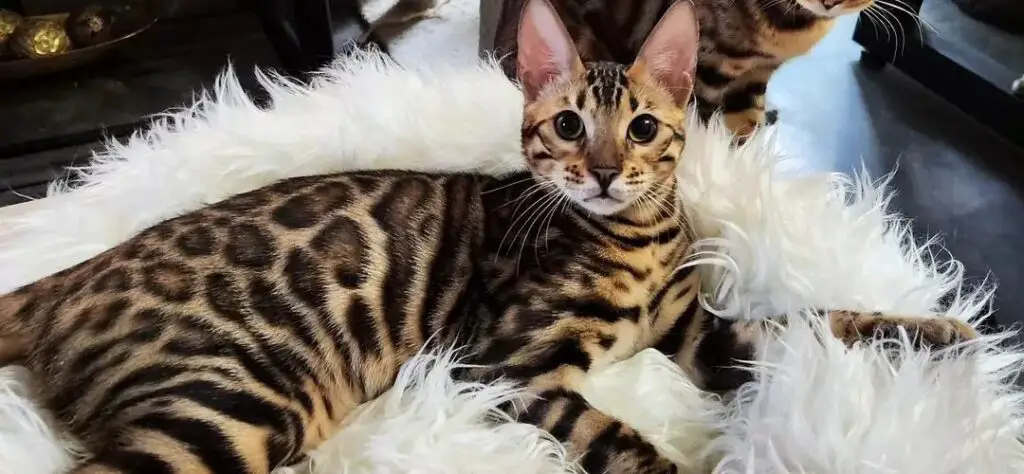As a big fan of Bengal cats, I understand they are high-energy cats that can be difficult to handle, this is why you should learn how to discipline them.
In this blog post, I’ll delve into the art of disciplining your Bengal cat with effective and gentle techniques that will have your Bengal cat behaving like a good cat in no time.
From setting boundaries to positive reinforcement, we’ve got all the tools you need to establish a harmonious relationship with your adventurous Bengal cat.
Let’s get started…
Common Bengal Cat Behaviors that May Require Discipline
In my opinion, there are some Bengal cat behaviors that you should pay attention to and discipline them.
If these behaviors are allowed to continue, they will eventually become a problem for you to your Bengal cat.
That being said, here are some common Bengal cat behaviors that may require discipline:
- Jumping on countertops
- Jumping on Sinks
- Scratching furniture
- Play aggression
- Unnecessarily biting stuff
- Fixating on other animals
- Unnecessarily meowing excessively
- Attacking stuff unnecessarily
- Destructive chewing
Disciplining Your Bengal Cat

When it comes to disciplining your cat, people have different opinions, some say it is wrong while some say it’s right.
However, I fall in the group of those who say it’s right if done the right way because if you don’t discipline your cat, they will keep spoiling things and showing behaviors that are not acceptable.
From what I know about Bengal cats, they are high-energy cats that require regular exercise and mental stimulation, which means they also require to be disciplined.
That being said, let’s look at some common ways of disciplining your Bengal cat:
Establishing Boundaries and Rules
Setting limits and regulations for your Bengal cat is a good way to discipline them.
Clearly defining boundaries enables your Bengal cat to distinguish between appropriate and inappropriate behavior.
First, establish boundaries between locations that belong to your cat and those that are off-limits.
Redirect your cat’s attention when they exhibit undesirable behavior and use positive reinforcement to encourage good behavior.
Make sure that everyone in your home follows the rules regularly and that they are all in agreement.
Consistency is important. Your Bengal cat will come to accept the limits and guidelines you have established with patience and time.
Give your Bengal cat 60 seconds time out
From my experience with cats, without proper discipline high energy cats like Bengal cats are likely to misbehave, which is why I suggest giving them a timeout when they misbehave.
Giving your Bengal cat a 60-second time-out can be a useful tactic for disciplining them.
Bengal cats require boundaries and direction to learn proper behavior, just like people do.
To use this method, locate a calm, special area where your cat can spend some time by themselves.
It might be a spare room or a cosy nook where their toys and bed are. Gently and calmly pick up your Bengal cat if they exhibit undesirable behavior, then put them in their time-out area.
Make sure they are not distracted and leave them there for sixty seconds. Let them go after the allotted time is up and carry on with your regular conversations.
This method helps them understand that their behavior is not acceptable and allows them to calm down before rejoining the family.
Using a Water Spray Bottle Mildly
Using water spray bottles might be a useful tool for disciplining your Bengal cat.
Given that certain Bengal cats have a reputation for being water-phobic, a spray bottle can be a useful deterrent.
Make sure you have a clean spray bottle with lukewarm water in it before using this procedure.
Give your Bengal cat a sharp “no” and quickly mist them with water if they start engaging in undesirable behavior, such as jumping on countertops or scratching furniture.
It’s important to aim for a light mist rather than a straight impact. In this manner, your cat will eventually learn to avoid the undesirable behavior by associating it with the water spray.
Always remember to provide positive reinforcement by guiding their focus to suitable toys or scratching posts.
Remember that consistency is essential, so make sure you use the water spray bottle only when required.
Your Bengal cat will learn to respect limits and behave properly given enough time and patience.
Using a Noisy Can
Although it can be difficult to discipline a Bengal cat, one useful strategy is to use loud distractions.
Use a noisy can as a distraction when your Bengal cat exhibits undesirable behavior, such as jumping on worktops or scratching furniture.
Just shake a tiny container full of coins or an empty soda can vigorously when it’s close to the cat. It will surprise the cat and divert its attention from the undesirable activity with the loud noise.
Your Bengal cat will eventually learn to associate the noise with the unwanted behavior if you use this technique on a regular basis.
To ensure a happy and well-behaved Bengal cat, always remember to combine this strategy with positive reinforcement and praise for good behavior.
Clapping Your Hands In the Process
You can discipline your Bengal cat well by clapping your hands.
Your cat may be startled and distracted from undesirable behavior by a sudden clap of your hands while they are jumping on countertops or scratching furniture.
All you have to do is watch your cat and wait for the right opportunity to catch them in the act.
Then give a sharp clap of your hands together, strong but not aggressive. They will become distracted by the loud sounds and change how they behave.
Keep in mind that cats respond best to positive reward and consistency in training, so employ this method sparingly and consistently.
Saying a Firm No in the Act

It can be difficult to discipline your Bengal cat, but setting boundaries with a stern “no” works well.
Say “no” to your cat politely and firmly while keeping eye contact when they engage in undesirable behavior, such as jumping on worktops or scratching furniture.
This makes it easier to express dissatisfaction and establish your dominance.
Reinforcing positive behavior involves pairing the firm “no” with guiding their focus to a suitable activity, like as using a specified perch or scratching post.
Repeating this technique repeatedly can assist your Bengal cat learn what is and is not acceptable.
Consistency is the key to this process. Saying a strong “no” can be a useful tool in Bengal cat discipline if you apply patience and tenacity.
Make the Correction in the Act And Not After the Act
Disciplining your Bengal cat effectively involves correcting them during the behavior rather than after it has occurred.
You can teach your Bengal cat what is appropriate behavior and inappropriate behavior by responding to them when they act out.
Say “no” to your Bengal cat politely and firmly when you find them doing anything wrong, such as leaping on worktops or clawing furniture.
You can also make an attention-grabbing noise, like a clap, to draw their attention.
Point them in the direction of a suitable substitute, like a designated climbing area or a scratching post.
Remember that consistency is important, so make sure to follow this procedure every time your Bengal cat misbehaves.
They will become more accustomed to expectations and acquire better habits with time and practice.
Remove Them From the Activity and Redirecting Them
Redirecting your Bengal cat’s attention and removing them from the activity might be a good way to discipline them.
Gently pick up your Bengal cat and move them to a different room or area if they are exhibiting behaviors you wish to discourage, including leaping on worktops or scratching furniture.
This will assist in stopping their present actions and focusing their attention in a different direction.
Make sure you give them something different to concentrate on, such as an interactive toy or a scratching post.
Since consistency is essential, repeat these steps whenever your Bengal cat exhibits undesirable behavior to encourage the desired behavior and deter the undesirable behavior.
Using Desensitization and Counter Conditioning
Counter-conditioning and desensitization are useful methods for training your Bengal cat.
In order to desensitize your cat to a certain stimulus that causes an undesired behavior, you must gradually expose them to it.
For instance, if your cat reacts negatively to strangers, you can begin by introducing them to a calm, quiet person at a distance and then progressively shorten the distance over time.
On the other hand, counter conditioning seeks to modify your cat’s emotional reaction to particular stimuli.
In a similar vein, you can establish a favorable association by associating the presence of strangers with enjoyable activities or treats.
Related: Bengal cat avoiding the litter box.
Precautions to Take When Disciplining a Bengal Cat

When it comes to disciplining your Bengal cat, it’s important to remember that they are highly intelligent and independent creatures.
In my opinion, here are some precautions to take or things to avoid when disciplining your Bengal cat:
1. Physical punishment: It’s crucial to never resort to physical punishment when disciplining your Bengal cat. Hitting, spanking, or any form of physical aggression can cause fear and anxiety, damaging the trust between you and your cat. Instead, focus on positive reinforcement techniques to encourage good behavior.
2. Yelling or shouting: Raising your voice or shouting at your Bengal cat can be counterproductive. Cats are sensitive to loud noises and may become fearful or stressed. Instead, use a calm and firm tone when addressing any unwanted behavior.
3. Ignoring or neglecting: Ignoring your Bengal cat’s bad behavior may seem like an easy solution, but it won’t effectively teach them what is acceptable and what isn’t. Consistency is key when it comes to discipline. It’s important to address any misbehavior promptly and redirect their attention to more appropriate activities.
4. Using punishment as the sole method: Relying solely on punishment may create a negative association between you and your Bengal cat. Instead, focus on positive reinforcement by rewarding good behavior with treats, praise, or playtime. This will encourage them to repeat the desired actions and strengthen the bond between you.
5. Inconsistent rules: Establishing consistent rules and boundaries is essential when disciplining your Bengal cat. Inconsistency can confuse them and lead to frustration. Ensure that all family members are on the same page when it comes to discipline and maintain a unified approach.
6. Not understanding their needs: Understanding your Bengal cat’s needs and behaviors is crucial for effective discipline. Cats may exhibit unwanted behaviors due to boredom, stress, or health issues. It’s important to identify the underlying cause of their behavior and address it accordingly. Provide them with stimulating toys, regular playtime, and a comfortable environment to prevent behavioral issues.
Related: Entertaining a Bengal cat.
Conclusion
So, there you have it! With these valuable insights and techniques, disciplining your Bengal cat doesn’t have to be a daunting task. Remember, consistency, patience, and positive reinforcement are key to shaping your cat’s behavior. With a little effort and a whole lot of love, you’ll soon enjoy a harmonious and well-behaved bond with your mischievous yet adorable Bengal companion!









